Do you have a question about the Singer 7470 and is the answer not in the manual?
Instructions to reduce the risk of electric shock from the sewing machine.
General warnings to prevent burns, fire, electric shock, or injury.
Identifies and labels the main parts of the sewing machine.
Lists all standard accessories provided with the sewing machine.
Instructions for connecting the power cord and foot control to the machine.
Explains the operation of the machine's power and light switch.
How to correctly place a thread spool on the horizontal spool pin.
How to correctly place a thread spool on the vertical spool pin.
Step-by-step guide for threading the top thread correctly.
How to check if the top thread is correctly threaded through the tension discs.
Guidance on adjusting thread tension for straight, zigzag, and decorative stitches.
Explains the LCD display, pattern navigation, and preference settings.
Details on how to select different stitch patterns and modes.
How to modify patterns, use twin needle, mirror image, and set sewing modes.
How to clear stored decorative and letter stitch patterns from memory.
Explains basic and continuous decorative stitches, including buttonholes.
Guide on how to select stitch patterns using the display and buttons.
How to adjust stitch width, length, and needle position for selected patterns.
Essential settings and initial steps for performing a straight stitch.
Techniques and aids for maintaining straight seams while sewing.
Guidance on inserting zippers and piping using the zipper foot.
Instructions for achieving a hand-sewn look for quilting.
How to utilize the auto tie-off feature for straight stitches.
Recommended settings and adjustments for width and length for zigzag stitches.
Information on the satin stitch, including its application and settings.
How needle position affects pattern placement and stitch width.
Recommended settings for blindhem stitch on different fabric types.
Step-by-step instructions for sewing blindhems.
Details on the strong straight stretch stitch, its uses, and applications.
Information on the overedge stitch used in garment industry for sportswear.
Describes the feather stitch for decorative purposes like top-stitching and lace.
Explains the ric-rac stitch for decorative edging and finishing.
Detailed guide on using the buttonhole foot for creating buttonholes.
How to select and combine letter and decorative stitch patterns.
Explains cursor movement, pattern checking, insertion, and deletion.
How to adjust stitch width, length, and memorize settings.
How to select and apply the mirror image function to patterns.
How to select and use the twin needle setting for sewing.
How to choose between single cycle and continuous sewing modes.
Creative ideas and examples for using decorative stitches on garments.
Instructions for cleaning the hook area and feed dogs for optimal machine performance.
Explains the benefits and application of the satin stitch foot.
Information and recommended practices for twin needle sewing.
Step-by-step instructions for threading the twin needle.
Common issues that prevent the machine from sewing or cause jamming.
Problems related to skipped stitches, irregular stitches, and needle breakage.
Issues concerning thread bunching, breakage, and fabric puckering.
Instructions to reduce the risk of electric shock from the sewing machine.
General warnings to prevent burns, fire, electric shock, or injury.
Identifies and labels the main parts of the sewing machine.
Lists all standard accessories provided with the sewing machine.
Instructions for connecting the power cord and foot control to the machine.
Explains the operation of the machine's power and light switch.
How to correctly place a thread spool on the horizontal spool pin.
How to correctly place a thread spool on the vertical spool pin.
Step-by-step guide for threading the top thread correctly.
How to check if the top thread is correctly threaded through the tension discs.
Guidance on adjusting thread tension for straight, zigzag, and decorative stitches.
Explains the LCD display, pattern navigation, and preference settings.
Details on how to select different stitch patterns and modes.
How to modify patterns, use twin needle, mirror image, and set sewing modes.
How to clear stored decorative and letter stitch patterns from memory.
Explains basic and continuous decorative stitches, including buttonholes.
Guide on how to select stitch patterns using the display and buttons.
How to adjust stitch width, length, and needle position for selected patterns.
Essential settings and initial steps for performing a straight stitch.
Techniques and aids for maintaining straight seams while sewing.
Guidance on inserting zippers and piping using the zipper foot.
Instructions for achieving a hand-sewn look for quilting.
How to utilize the auto tie-off feature for straight stitches.
Recommended settings and adjustments for width and length for zigzag stitches.
Information on the satin stitch, including its application and settings.
How needle position affects pattern placement and stitch width.
Recommended settings for blindhem stitch on different fabric types.
Step-by-step instructions for sewing blindhems.
Details on the strong straight stretch stitch, its uses, and applications.
Information on the overedge stitch used in garment industry for sportswear.
Describes the feather stitch for decorative purposes like top-stitching and lace.
Explains the ric-rac stitch for decorative edging and finishing.
Detailed guide on using the buttonhole foot for creating buttonholes.
How to select and combine letter and decorative stitch patterns.
Explains cursor movement, pattern checking, insertion, and deletion.
How to adjust stitch width, length, and memorize settings.
How to select and apply the mirror image function to patterns.
How to select and use the twin needle setting for sewing.
How to choose between single cycle and continuous sewing modes.
Creative ideas and examples for using decorative stitches on garments.
Instructions for cleaning the hook area and feed dogs for optimal machine performance.
Explains the benefits and application of the satin stitch foot.
Information and recommended practices for twin needle sewing.
Step-by-step instructions for threading the twin needle.
Common issues that prevent the machine from sewing or cause jamming.
Problems related to skipped stitches, irregular stitches, and needle breakage.
Issues concerning thread bunching, breakage, and fabric puckering.
| Built-in Stitches | 70 |
|---|---|
| Buttonhole Styles | 6 |
| Stitch Width | 7mm |
| Stitch Length | 5mm |
| Sewing Speed | 750 stitches per minute |
| LCD Screen | Yes |
| Automatic Needle Threader | Yes |
| Drop Feed | Yes |
| Free Arm | Yes |
| Type | Electronic |
| Top Drop-in Bobbin | Yes |
| Voltage | 110V |
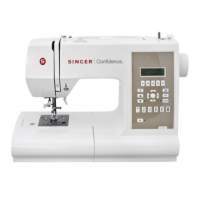
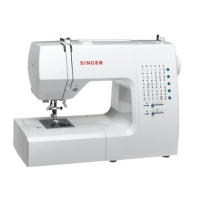
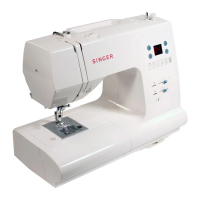
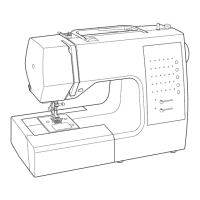
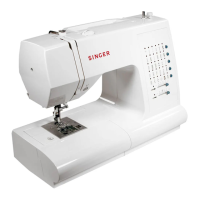

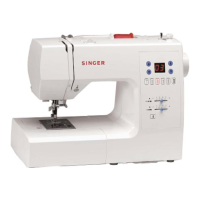
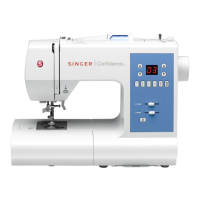
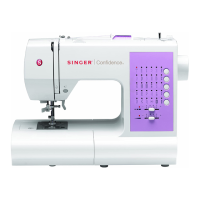
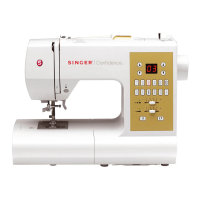
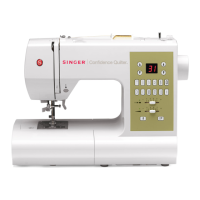
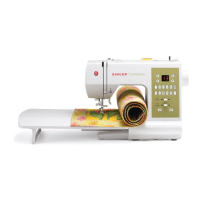
